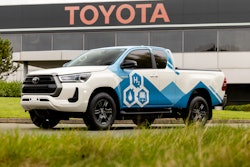One way to try to predict the future is to possess an implicit understanding of market trends and the ability to analyze data. Even then, there is no guarantee what seems obvious on paper will come to pass.
This is true when it comes to commercial and vocational trucks and the fuels they will use in 2027 and beyond. Will Class 3-7 fleet trucks shift from diesel and gasoline to one primary alternative fuel, such as electric or propane? How will actual and perceived ease of alternative fuel use impact vehicle choice? What will tax incentives and financial assistance look like in the future? When it comes to propane-fueled vehicles, what advances and innovations are on the horizon? And how will the upcoming election cycle impact the push for electric vehicles?
First, there is not likely to be a silver bullet, as fleets have multiple classes of vehicles with different duty cycles, payloads and range needs. There are some great battery-electric/hybrid options in Class 1-2, but as you get to Class 4-7, there likely will be a mix of propane, natural gas and gasoline.
I think gasoline will continue to be a viable option in this decade; however, diesel will struggle with the tightening nitrogen oxide (NOx) regulations that will significantly increase the cost and complexity in a vocational truck. Based on tightening regulations, it would not surprise me to see diesel no longer offered in Class 4-7 vocational trucks due to the added cost, complexity and warranty burden by state and federal agencies. Diesel will still have its place in some key strongholds such as Class 8.
Fleets really like the simple design and serviceability of an engine like Ford’s 7.3L Godzilla. The challenge will be how manufacturers continue to manage investments in capital intensive programs like EV and fuel cell while also continuing to innovate on the spark-ignited front. Time will tell, but my educated guess is that spark-ignited engines will be around for a lot longer than many are currently predicting based on all of the current headwinds for EV.
I believe that propane will play a significant role in the transformation of commercial trucks as it has too many positive attributes for fleets to ignore. It is clean, domestic and abundant; fueling infrastructure is low cost; there is no significant impact on range or payload; and it drives a substantial reduction in cost per mile to operate.
All that leads into funding — what will tax incentives and financial assistance look like in the future? There is a significant influx of money available at the federal and state levels to assist fleets in the transition from diesel to something cleaner. For propane, there is a federal excise tax credit of $0.36 per gallon consumed. This incentive is available through the end of 2024 and may be extended based on the current landscape in the nation’s capital. As we progress through the decade, the diesel engine will get significantly more expensive, so the upfront price gap of a propane vehicle will shrink or disappear entirely.
That’s all to say cost is a big factor in selecting an alternatively fueled vehicle, but so is relative ease of use. Electric vehicles have received the lion’s share of funding and spotlight. At Roush, we believe there is a bright future for that technology. But in complex vocational trucks, electric has a long way to go to become mainstream. While the electric vehicle infrastructure and supply chain matures, propane will play a key role in helping fleets move to a solution that drives a reduction in harmful emissions and delivers significant cost savings.
Finally, what advances and innovations can you expect from the propane industry? Propane is a fuel that is clean, value-priced and ample, but the industry has recognized that it needs to continue to reduce its carbon intensity to have a place in the long-term transportation discussion. The development and growing supply of renewable propane is a huge breakthrough for fleets that value the simplicity and low cost of propane; they can begin implementing a renewable variant into their operation. When you look at the carbon intensity of renewable propane, it is cleaner well-to-wheels than our nation’s electric grid in 49 states.
There is an old proverb that states: May you live in interesting times. When it comes to alternatively fueled vehicles, we already are, and I anticipate that we will for years to come.









